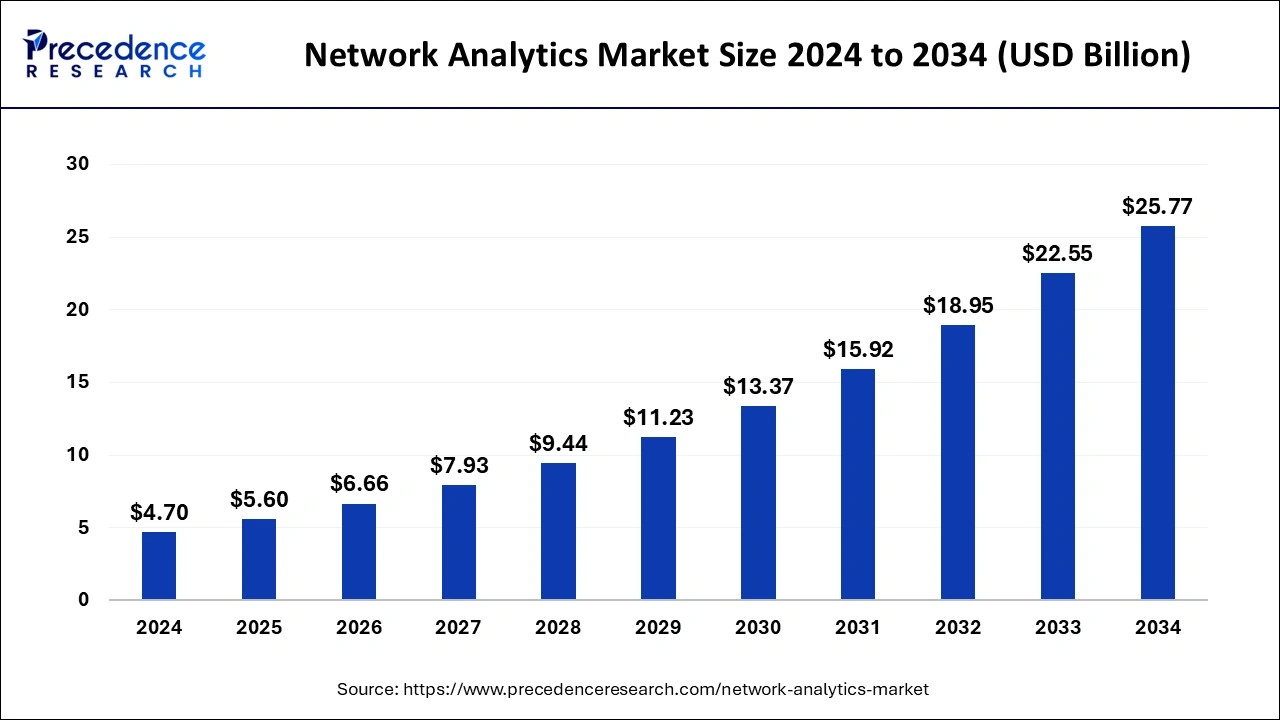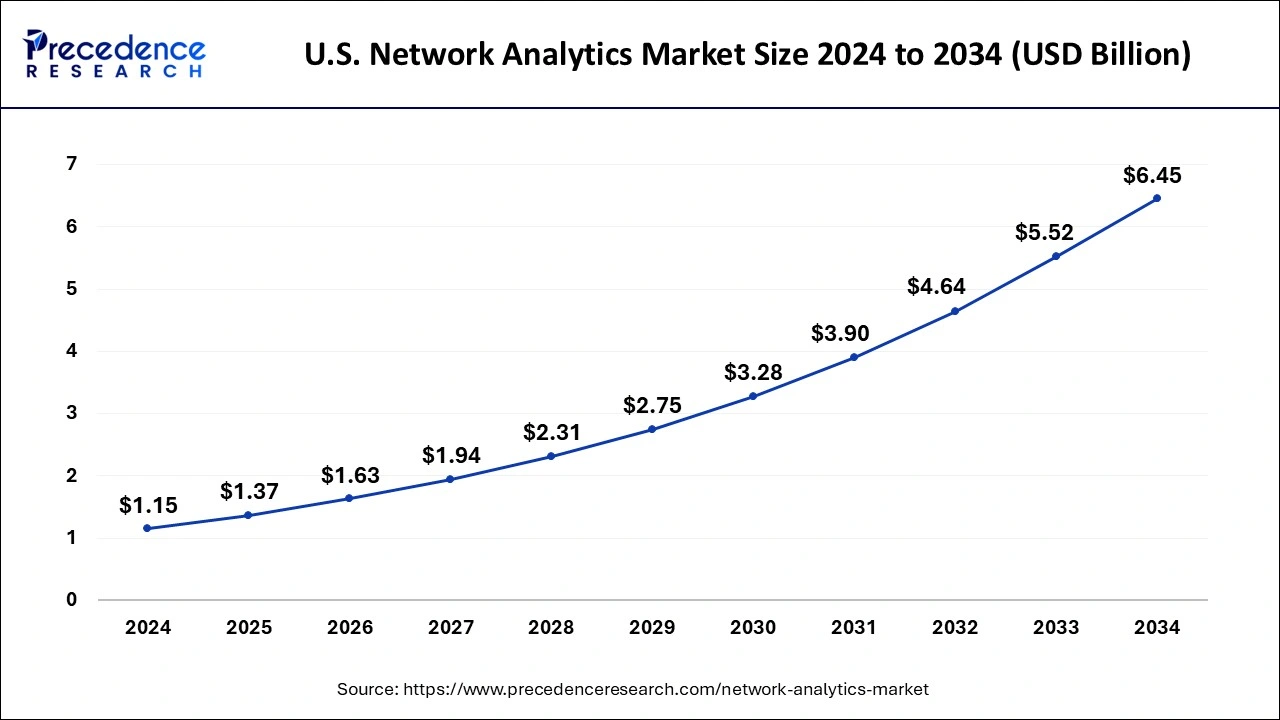February 2025
The global network analytics market size is calculated at USD 5.60 billion in 2025 and is forecasted to reach around USD 25.77 billion by 2034, accelerating at a CAGR of 18.55% from 2025 to 2034. The North America network analytics market size surpassed USD 1.65 billion in 2024 and is expanding at a CAGR of 18.68% during the forecast period. The market sizing and forecasts are revenue-based (USD Million/Billion), with 2024 as the base year.
The global network analytics market size was estimated at USD 4.70 billion in 2024 and is predicted to increase from USD 5.60 billion in 2025 to approximately USD 25.77 billion by 2034, expanding at a CAGR of 18.55% from 2025 to 2034.

The U.S. network analytics market size was estimated at USD 1.15 billion in 2024 and is projected to surpass around USD 6.45 billion by 2034 at a CAGR of 18.82% from 2025 to 2034.

North America held a share of 35% in the network analytics market due to several factors. The region boasts advanced telecommunications infrastructure, high internet penetration rates, and a strong presence of key market players. Moreover, North American businesses prioritize digital transformation initiatives and invest significantly in cutting-edge technologies, including Network Analytics solutions, to enhance operational efficiency and maintain a competitive edge. Additionally, favorable government regulations and initiatives supporting the adoption of advanced networking technologies contribute to the region's dominance in the network analytics market.
Asia-Pacific is experiencing rapid growth in the network analytics market due to several factors. Firstly, the region's expanding digital infrastructure and increasing adoption of advanced technologies such as 5G, IoT, and cloud computing are generating vast amounts of network data, driving the demand for analytics solutions. Additionally, rising cybersecurity concerns and a growing emphasis on enhancing network performance and user experience are prompting organizations across various industries to invest in network analytics tools. Moreover, favorable government initiatives and the presence of key market players are further fueling market growth in the Asia-Pacific region.

Meanwhile, Europe is experiencing notable growth in the network analytics market due to several factors. Firstly, the region's rapid adoption of advanced technologies like 5G, IoT, and cloud computing is driving the demand for network analytics solutions to manage and optimize these complex infrastructures. Additionally, stringent data privacy regulations, such as GDPR, are prompting organizations to invest in network analytics tools for enhanced security and compliance. Furthermore, the increasing digitalization across industries, coupled with a focus on improving operational efficiency and customer experience, is fueling the uptake of network analytics solutions in Europe.
Network analytics refers to the process of gathering and analyzing data from computer networks to gain insights into their performance, security, and overall health. By monitoring network traffic, devices, and interactions, network analytics helps identify patterns, anomalies, and potential issues. This information can be used to optimize network performance, detect, and mitigate security threats, and improve overall efficiency. Using specialized software and algorithms, network analytics tools can visualize network data, generate reports, and provide real-time alerts to network administrators. These insights enable organizations to make informed decisions about network design, capacity planning, and resource allocation. Ultimately, network analytics plays a crucial role in ensuring that networks operate smoothly, securely, and cost-effectively, helping businesses and organizations to meet their connectivity needs while maximizing productivity and minimizing downtime.
Network Analytics Market Data and Statistics
| Report Coverage | Details |
| Growth Rate from 2025 to 2034 | CAGR of 18.55% |
| Global Market Size in 2025 | USD 5.60 Billion |
| Global Market Size by 2034 | USD 25.77 Billion |
| Largest Market | North America |
| Base Year | 2024 |
| Forecast Period | 2025 to 2034 |
| Segments Covered | By Component, By Enterprise Size, By End-user, and By Application |
| Regions Covered | North America, Europe, Asia-Pacific, Latin America, and Middle East & Africa |
Escalating volume of data traffic
The escalating volume of data traffic is a significant driver for the network analytics market. As more devices connect to networks and people consume increasingly data-intensive content like videos and games, the strain on networks grows. This surge in data traffic creates challenges for network operators in managing, optimizing, and securing their infrastructure. Network analytics solutions play a crucial role in addressing these challenges by providing insights into network performance, identifying bottlenecks, and predicting capacity requirements.
Moreover, as data traffic continues to increase, businesses and organizations are under pressure to ensure a seamless user experience and maintain operational efficiency. Network Analytics tools help them achieve this by offering real-time visibility into network activity, enabling proactive monitoring, and facilitating rapid problem resolution. Therefore, the escalating volume of data traffic not only highlights the importance of Network Analytics in managing network congestion and optimizing resource allocation but also drives the market demand for advanced solutions that can handle the growing complexity of modern networks.
Integration challenges with existing infrastructure
Integration challenges with existing infrastructure can hinder the market demand for network analytics solutions. Many organizations have complex and heterogeneous IT environments, comprising a mix of legacy systems, proprietary technologies, and cloud-based platforms. Integrating new network analytics tools with such diverse infrastructures often proves challenging due to compatibility issues, interoperability constraints, and data silos. These integration hurdles can slow down the deployment process, increase implementation costs, and impede the seamless operation of network analytics solutions within the existing ecosystem.
Moreover, the complexity of integration processes can deter organizations from adopting network analytics solutions altogether. The need for specialized expertise and resources to navigate integration challenges adds to the perceived barriers, especially for small and medium-sized businesses with limited IT budgets and technical capabilities. As a result, integration challenges with existing infrastructure act as significant restraints on the market demand for network analytics solutions, limiting their adoption and hindering organizations from harnessing the full potential of analytics-driven insights for network management and optimization.
Rising demand for real-time analytics
The rising demand for real-time analytics presents significant opportunities in the network analytics market. As businesses strive to stay competitive in today's fast-paced digital landscape, the need for instant insights into network performance, security threats, and user behavior becomes paramount. Real-time analytics solutions enable organizations to monitor their networks continuously, detect anomalies or issues as they occur, and respond promptly to prevent disruptions. This capability not only enhances operational efficiency but also minimizes downtime, improves user experience, and strengthens overall network security.
Moreover, real-time analytics empower organizations to make data-driven decisions in the moment, enabling agile and proactive network management strategies. By leveraging real-time insights, businesses can optimize network resources, allocate bandwidth dynamically, and prioritize critical applications or services in response to changing demands. As a result, the rising demand for real-time analytics drives innovation in the network analytics market, leading to the development of advanced solutions that offer instantaneous visibility, actionable intelligence, and predictive capabilities to meet the evolving needs of modern enterprises.
The network intelligence solutions segment held the highest market share of 65% in 2024. The network intelligence solutions segment in the network analytics market refers to software and tools that provide deep insights into network performance, security, and user behaviour. These solutions utilize advanced analytics techniques, such as machine learning and AI, to analyse vast amounts of network data in real time, enabling organizations to make informed decisions and optimize their network operations effectively. Trends in this segment include the integration of AI-driven automation, enabling predictive maintenance and proactive network management. Additionally, there is a growing focus on enhancing security intelligence capabilities to detect and mitigate cyber threats in real time, reflecting the increasing importance of network security in today's digital landscape.
The services segment is anticipated to witness rapid growth at a significant CAGR of 20.22% during the projected period. In the network analytics market, the services segment typically encompasses a range of offerings provided by vendors or third-party providers to support the implementation, integration, customization, and ongoing maintenance of network analytics solutions. These services may include consulting, deployment, training, support, and managed services. One prominent trend in the services segment of the network analytics market is the increasing demand for managed services, where organizations outsource the management and operation of their network analytics infrastructure to specialized service providers. This allows businesses to leverage the expertise and resources of external partners to optimize their network performance, enhance security, and ensure regulatory compliance while focusing on their core operations.
The large enterprise segment held a 61% market share in 2024. Large enterprises, typically characterized by extensive operations and significant resources, form a crucial segment in the network analytics market. They often have complex and distributed network infrastructures, driving demand for advanced analytics solutions to optimize performance, enhance security, and support digital transformation initiatives. Trends indicate increasing adoption of cloud-based analytics platforms and AI-driven insights among large enterprises to streamline network management and bolster competitive edge.
The small and medium enterprises (SMEs) segment is anticipated to witness rapid growth over the projected period. Small and medium enterprises (SMEs) typically refer to businesses with fewer than 500 employees. In the network analytics market, SMEs are increasingly adopting scalable and cost-effective solutions to monitor and optimize their networks. Trends show a growing demand for cloud-based network analytics tools tailored to SMEs' specific needs and budgets.
The telecom providers segment has held a 36% market share in 2024. Telecom providers, also known as telecommunications service providers, are companies that offer communication services such as voice, data, and internet connectivity to consumers and businesses. In the network analytics market, telecom providers are increasingly adopting analytics solutions to enhance network performance, optimize resources, and improve customer experiences.
The cloud service providers segment is anticipated to witness rapid growth over the projected period. Cloud service providers are companies that offer various cloud-based services, including infrastructure, platforms, and software, to businesses and individuals over the internet. In the network analytics market, the cloud service providers segment refers to those organizations that provide network analytics solutions as part of their cloud offerings. A prominent trend in this segment is the integration of advanced analytics capabilities into cloud platforms, enabling users to gain insights into their network performance, security, and efficiency seamlessly. Additionally, cloud service providers are focusing on enhancing scalability, flexibility, and real-time analytics capabilities to meet the evolving demands of their customers for robust network management solutions.
The network performance management segment has held a 31% market share in 2024. Network performance management in the network analytics market refers to the practice of monitoring, analyzing, and optimizing the performance of computer networks. This segment focuses on assessing network speed, reliability, and efficiency to ensure optimal operation and user experience. Key trends in network performance management include the increasing adoption of real-time monitoring tools, the integration of AI and machine learning for predictive analytics, and the emphasis on cloud-based solutions for scalability and flexibility in managing network performance.
The quality management segment is anticipated to witness rapid growth over the projected period. In the network analytics market, quality management focuses on assessing and optimizing the performance and reliability of network services. This segment involves monitoring parameters such as latency, packet loss, and jitter to ensure that network resources meet predefined quality standards. Trends in quality management include the integration of advanced analytics techniques, such as machine learning and AI, to proactively identify and address potential issues before they impact user experience. Additionally, there is a growing emphasis on real-time analytics to provide immediate insights into network quality and facilitate prompt remediation actions.
By Component
By Enterprise Size
By End-user
By Application
By Geography
For inquiries regarding discounts, bulk purchases, or customization requests, please contact us at sales@precedenceresearch.com
No cookie-cutter, only authentic analysis – take the 1st step to become a Precedence Research client
February 2025
November 2024
January 2025
November 2024